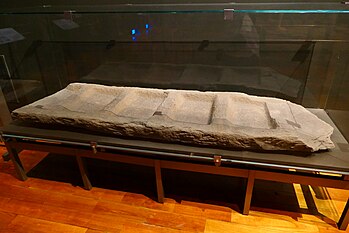The stone ladder, also known as a stone container[1] or large stone trough[2] in its early stages when its function was not clear, is an archaeological artifact discovered in Taiwan that is now believed to have a high probability of being used as a ladder based on use-wear, morphology, and computer simulation of data.[3][4]

Early studies on the stone ladder suggested that it was made of graywacke, metasandstone, and schist. However, recent observations indicate that it was more likely made of a single piece of quartz-mica slate.[4]: 146, 154
Initially, based on ethnographic analogies and references to the lifestyles of the Amis and Tao people, it was believed that the stone ladder might have been used as a feed trough for pigs.[1][4] However, the observation of a single slope side, coupled with the evidence of unidirectional wear on surfaces, now supports the function of the artifact, which was primarily used as a ladder.[3]
Subsequent observations, digital simulations, and statistical analysis have revealed that the central part of the inclined surface is smoother compared to the sides, suggesting that it was the main area used for climbing.[4]: 155 Additionally, the first step of the ladder exhibits less use-wear, indicating that it was likely the initial point of contact during ascent. Through calculations by computer software, experts estimated that the angle of inclination for leaning against the ladder was approximately between 40 and 60 degrees, and the climbing height could reach around 110-130 centimeters.[4]: 155
To date, a total of 14 recorded excavated stone ladders have been discovered at the Peinan Site, with an additional one found at the Laofanshe Site.[4][5] These artifacts are predominantly rectangular-shaped with 5-6 ladder grooves. The solid and heavy structure of the stone ladder, along with the requirement for large stone blocks during its construction, has led some scholars to speculate that it was not used for ordinary housing purposes.[3]
One stone ladder, excavated from the Peinan Site and known as the "Peinan Culture Rock Carving Stone Ladder," was officially designated as an important cultural artifact in 2014. It is currently stored at the National Museum of Prehistory in Taiwan.[6][7]
References
edit- ^ a b 金關丈夫 (Kanaseki Takeo); 國分直一 (Kokubu Naoichi) (1990-09-01) [1979]. 台湾考古誌 [台灣考古誌] (in Chinese (Taiwan)). Translated by 譚繼山 (Tan Ji-Shan). 臺北: 武陵. ISBN 9573501635.
- ^ 宋文薰 (Sung Wen-Hsun); 連照美 (Lien Chao-Mei) (1988). "卑南遺址第11-13次發掘工作報告". 《國立臺灣大學考古人類學專刊》 (in Chinese (Taiwan)). 第十二種. 臺灣臺北: 國立臺灣大學人類學系.
- ^ a b c 葉美珍 (Yeh Mei-Chen) (2004). 卑南遺址與文化——概要及書目彙編. 臺東: 臺東縣政府.
- ^ a b c d e f 葉長庚 (Yeh Chang-Keng) (2016). "更上半層樓:卑南遺址出土石梯之研究 (Take a Step Up: Research on the Stone Ladders of the Peinan Site)" (PDF). 《考古人類學刊》 (in Chinese (Taiwan)) (85). 國立臺灣大學人類學系: 139–172. doi:10.6152/jaa.2016.12.0006. Retrieved 2022-12-21.
- ^ 葉美珍 (Yeh Mei-Chen) (2021-01-01). "談老番社遺址近年之考古調查". 發現史前館電子報 (434). 國立臺灣史前文化博物館 (National Museum of Prehistory).
- ^ "卑南文化岩雕石梯". 國家文化資產網 (in Chinese (Taiwan)). 文化部文化資產局. Retrieved 2022-12-21.
- ^ "卑南文化岩雕石梯". 國立臺灣史前文化博物館 (in Chinese (Taiwan)). Retrieved 2022-12-21.